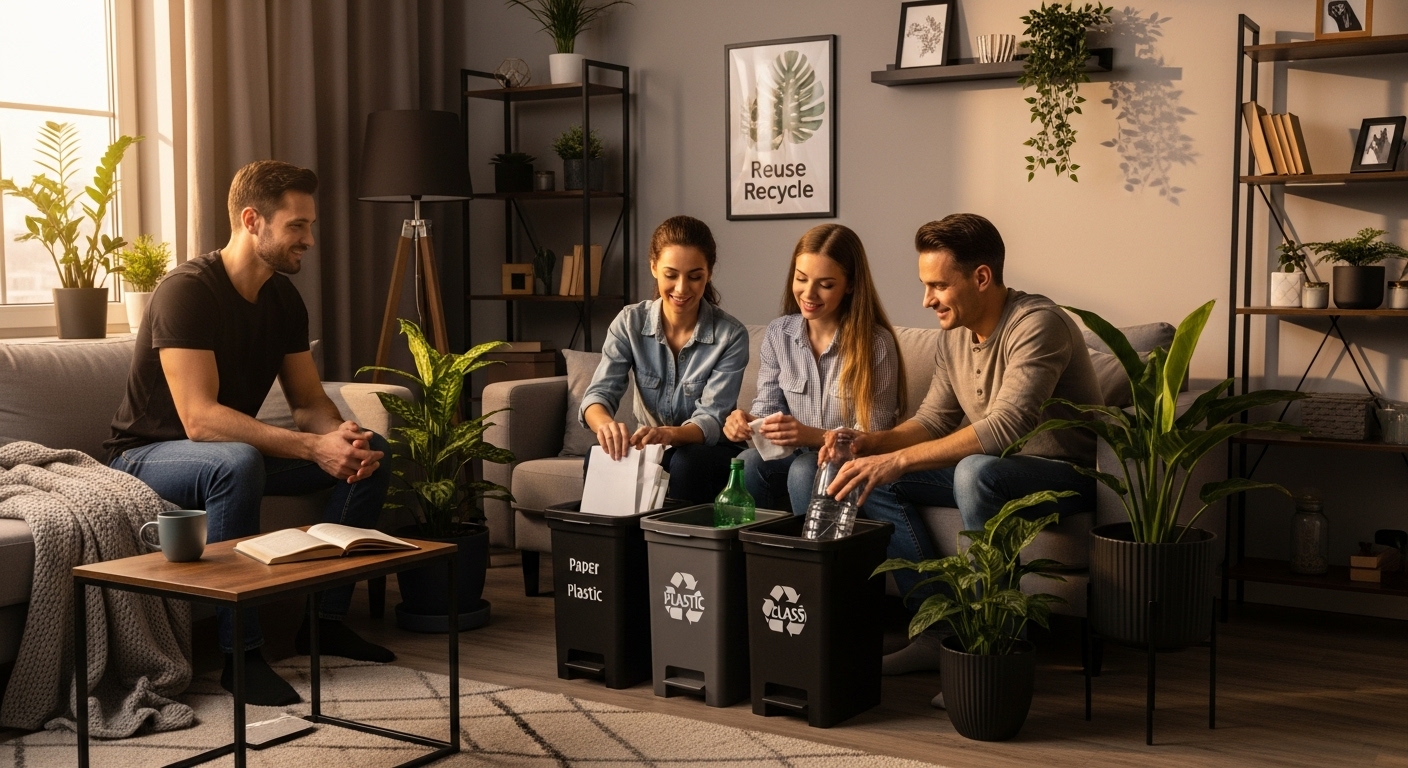Sustainable living is quickly becoming more than just a buzzword. People across the globe are changing habits and rethinking everything they consume. The average American generates over 4 pounds of trash daily, and that mountain of waste is only growing. Most people assume eco-friendly living demands perfection or dramatic changes, but the real power of sustainable living lies in small, consistent choices that anybody can make starting right now.
Table of Contents
- What Is Sustainable Living? A Fundamental Definition
- Why Sustainable Living Matters: The Impact On Our Planet
- How Sustainable Practices Work: Principles Of Eco-Friendliness
- Key Concepts In Sustainable Living: Reduce, Reuse, Recycle
- Practical Applications Of Sustainable Living In Daily Life
Quick Summary
| Takeaway | Explanation |
|---|---|
| Reduce personal consumption | Lowering your consumption decreases your carbon footprint and environmental impact. Focus on what you truly need before making a purchase. |
| Embrace the 3Rs: Reduce, Reuse, Recycle | By prioritizing these principles, you can minimize waste and maximize resource efficiency in your daily life. Start with reducing what you buy. |
| Integrate sustainability into daily habits | Simple actions like using energy-efficient products and reducing single-use items can add up to significant ecological benefits without drastic lifestyle changes. |
| Support sustainable local businesses | Choosing local products helps reduce transportation emissions and promotes community health. Align your purchasing habits with sustainability values. |
| Make conscious energy choices | Educate yourself on energy-efficient practices and renewable sources to reduce your household’s ecological impact significantly. Every small change counts. |
What is Sustainable Living? A Fundamental Definition
Sustainable living represents a transformative approach to daily life that prioritizes environmental responsibility and conscious resource management. At its core, this lifestyle strategy seeks to minimize individual and collective ecological impact while maintaining quality of life and preserving natural systems for future generations.
Understanding the Core Principles
Sustainable living is fundamentally about making intentional choices that reduce personal consumption and environmental strain. According to the United Nations Sustainable Development Goals, this approach involves strategically managing personal and societal resources to ensure long term planetary health.
Key principles of sustainable living include:
- Reducing personal carbon footprint
- Minimizing waste generation
- Conserving natural resources
- Prioritizing renewable energy sources
- Supporting ecological balance
Environmental and Personal Impact
Beyond environmental benefits, sustainable living offers significant personal advantages. By adopting more mindful consumption patterns, individuals can simultaneously reduce expenses, improve personal health, and contribute to global ecological preservation.
The following table summarizes the core principles and personal/environmental impacts of sustainable living for quick reference.
| Principle/Impact | Description |
|---|---|
| Reduce personal carbon footprint | Making choices that minimize greenhouse gas emissions tied to energy, transportation, and consumption. |
| Minimize waste generation | Adopting habits that limit landfill contributions through reduced consumption and better waste segregation. |
| Conserve natural resources | Using water, energy, and materials efficiently to preserve resources for the future. |
| Prioritize renewable energy | Choosing solar, wind, or other sustainable energy sources over fossil fuels. |
| Support ecological balance | Engaging in practices that maintain biodiversity and natural ecosystem health. |
| Improve personal health | Opting for cleaner air, water, and lifestyle choices that benefit well-being. |
| Reduce expenses | Saving money by consuming less, repairing, and making long-lasting purchases. |
| These lifestyle modifications range from simple daily habits like recycling and energy conservation to more comprehensive changes in transportation, diet, and consumer behavior. |
Sustainable living is not about perfection but consistent, incremental improvements. Each conscious choice represents a meaningful step toward creating a more resilient and balanced relationship between human activities and the natural world. Whether through reducing single use plastics, choosing energy efficient appliances, or supporting local sustainable agriculture, every action contributes to a broader ecological restoration effort.
Why Sustainable Living Matters: The Impact on Our Planet
Sustainable living transcends individual actions and represents a critical global strategy for addressing the most pressing environmental challenges of our time. The interconnected nature of ecological systems means that every personal choice contributes to a larger planetary narrative of conservation, restoration, and responsible resource management.
Global Environmental Consequences
The environmental stakes are significant and immediate. According to the U.S. Environmental Protection Agency, sustainability is about creating conditions where humans and nature can coexist productively, supporting both present and future generations. Climate change, biodiversity loss, and resource depletion are not distant threats but current realities demanding urgent collective action.
Key environmental challenges include:
This table highlights key global environmental challenges addressed by sustainable living, clarifying their impact and urgency.
| Environmental Challenge | Description |
|---|---|
| Rising global temperatures | Climate change driven by human activity leads to unfavorable shifts in weather. |
| Rapid species extinction | Loss of biodiversity as habitats are destroyed and ecosystems destabilized. |
| Diminishing freshwater resources | Overuse and pollution are making clean water less accessible worldwide. |
| Extreme weather events | Increased frequency of hurricanes, droughts, and floods tied to global warming. |
| Oceanic ecosystem disruption | Pollution, overfishing, and warming oceans threaten marine life and coastal health. |
- Accelerating global temperature increases
- Rapid species extinction rates
- Diminishing freshwater resources
- Increasing frequency of extreme weather events
- Oceanic ecosystem disruption
Personal Responsibility and Collective Impact
While global environmental challenges might seem overwhelming, individual actions create meaningful change. Each sustainable choice acts as a ripple effect, influencing personal habits, community practices, and broader economic systems. Reducing personal carbon footprints, supporting sustainable businesses, and advocating for environmentally responsible policies can drive significant systemic transformations.
Sustainable living is not about perfection but consistent engagement. By understanding our ecological interdependence, we recognize that protecting planetary health directly correlates with ensuring human survival and prosperity. Every conscious decision whether in energy consumption, waste reduction, or consumer choices represents a vote for a more resilient and balanced global ecosystem.
How Sustainable Practices Work: Principles of Eco-Friendliness
Sustainable practices represent a holistic approach to living that integrates environmental consciousness into everyday decision making. These practices are not about radical lifestyle overhauls but strategic, incremental changes that collectively create substantial positive ecological impact.
Core Mechanisms of Sustainability
According to the United Nations Environment Programme, sustainable living involves making deliberate choices that minimize environmental harm and optimize resource consumption. The fundamental mechanisms operate through conscious consumption, waste reduction, and systemic efficiency.
Key operational principles include:
- Reducing resource consumption
- Maximizing energy efficiency
- Implementing circular economy concepts
- Prioritizing renewable alternatives
- Creating closed loop systems
Interconnected Ecological Strategies
Sustainable practices function through interconnected strategies that address environmental challenges at multiple levels. These approaches transform individual actions into comprehensive systemic changes by recognizing the complex relationships between human activities and natural ecosystems.
By understanding ecological interdependence, sustainable practices create a framework where personal choices directly contribute to broader environmental preservation. Whether through energy conservation, responsible purchasing, or waste minimization, each action becomes part of a larger regenerative approach that supports planetary health and human well being.
Key Concepts in Sustainable Living: Reduce, Reuse, Recycle
The principles of reduce, reuse, and recycle form the foundational framework for sustainable living. These interconnected strategies represent a powerful approach to minimizing waste, conserving resources, and creating more environmentally responsible consumption patterns.
Understanding Waste Reduction Strategies
According to the U.S. Environmental Protection Agency, reducing and reusing are the most effective methods for saving natural resources and protecting the environment. This approach prioritizes prevention of waste generation before considering recycling as an alternative solution.
Key waste reduction strategies include:
- Purchasing only essential items
- Selecting products with minimal packaging
- Choosing durable and long lasting goods
- Repairing items instead of replacing them
- Avoiding single use products
Transformative Consumption Principles
Reducing consumption goes beyond simple material conservation. It represents a fundamental shift in how we perceive resource utilization. By making intentional choices, individuals can significantly decrease their environmental footprint. Learn more about home organization strategies that support sustainable living principles.
The cycle of reduce, reuse, and recycle creates a comprehensive approach to resource management. Reducing minimizes initial consumption, reusing extends product lifecycles, and recycling transforms waste into new materials. This holistic strategy transforms waste from an endpoint into a continuous resource loop, promoting a more sustainable and circular economic model.
![]()
Practical Applications of Sustainable Living in Daily Life
Sustainable living transforms theoretical environmental principles into tangible, everyday actions. By integrating conscious choices into routine activities, individuals can create meaningful ecological impact without requiring radical lifestyle transformations.
Home Resource Management
According to the United Nations Sustainable Development Goals, sustainable consumption involves strategically redesigning daily processes to minimize resource waste and maximize efficiency. This approach encompasses multiple aspects of home life, from energy consumption to waste management.
Practical home sustainability strategies include:
- Installing energy efficient appliances
- Implementing water conservation techniques
- Using natural cleaning products
- Reducing household energy consumption
- Creating home composting systems
Everyday Sustainable Choices
Sustainable living extends beyond home infrastructure into daily consumer decisions. Simple modifications like choosing reusable containers, purchasing locally sourced products, and exploring smart organization solutions can significantly reduce personal environmental footprints. These incremental changes compound over time, creating substantial positive ecological impact.
The table below organizes practical sustainable living actions you can implement at home for resource management and reducing ecological impact.
| Area | Sustainable Action | Benefit |
|---|---|---|
| Energy | Install energy-efficient appliances | Reduce utility costs and carbon footprint |
| Water | Use low-flow fixtures and conserve water | Save water and lower bills |
| Cleaning | Switch to natural cleaning products | Limit toxic chemicals and indoor pollution |
| Waste | Create home composting systems | Reduce landfill waste, enrich soil |
| Daily Products | Choose reusable containers | Cut single-use plastic waste |
| Purchases | Buy locally sourced products | Lower transport emissions, support locals |

By approaching sustainability as a continuous journey of mindful choices rather than a destination, individuals can seamlessly integrate environmentally responsible practices into their lifestyle. Each conscious decision represents a vote for planetary health, demonstrating that personal actions can collectively drive meaningful environmental transformation.
Transform Your Home Organization for Sustainable Living
Are you finding it hard to maintain a neat, eco-friendly home while juggling daily life? As the article explains, sustainable living is about more than recycling: it is about reducing waste, reusing what you have, and organizing your space for efficiency and balance. Many face clutter and disorganization that lead to excess consumption and lost time—feeling overwhelmed by stuff and unsure where to start. Imagine turning every corner into a functional, beautiful, and sustainable space.

Start putting sustainable living tips into action today. Shop high-quality and stylish storage solutions at BlushBees to make organization easier and reduce waste at home. Looking for practical ideas? Explore this guide on home organization strategies or get inspired by smart organization solutions for busy homes. Make your next purchase count for you and the planet. Visit BlushBees now and take your first step toward a sustainable, organized home.
Frequently Asked Questions
What are some simple sustainable living tips for my home?
Simple sustainable living tips include installing energy-efficient appliances, using natural cleaning products, and implementing water conservation techniques like using low-flow fixtures.
How can I reduce my carbon footprint at home?
You can reduce your carbon footprint by minimizing energy use, opting for renewable energy sources, and choosing sustainable transportation options for daily commutes.
What does the concept of reduce, reuse, and recycle encompass in sustainable living?
The concept involves minimizing waste by purchasing only essential items, reusing materials whenever possible, and recycling products to prevent adding to landfills, thereby supporting a circular economy.
How can I integrate sustainability into my daily habits?
You can integrate sustainability into daily habits by making conscious decisions such as using reusable containers, choosing locally sourced products, and practicing energy conservation in your home.
Recommended
- 10 Home Organization Tips for a More Tidy and Efficient Living Space – BLUSHBEES USA
- Bathroom Counter Organization Ideas for Stylish and Busy Homes (2025) – BLUSHBEES USA
- Shelf Organization Ideas for Stylish and Smart Storage 2025 – BLUSHBEES USA
- Top Closet Cleanout Tips for Busy Homes in 2025 – BLUSHBEES USA



